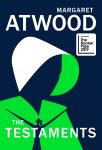In the 34 years since the publication of The Handmaid’s Tale, author Margaret Atwood’s creation has become something of a phenomenon. Whether read as a feminist text or a vision of a dystopian future, the novel has been endlessly dissected and discussed by millions. Indeed, the Hulu series has only heightened its relevancy, with parallels between the current US government and Gilead oft made.
Yet the fear of a slide from democracy to dictatorial theocracy is universal. “The citizens of many countries, including the United States,” acknowledges Atwood in an afterword, “are under more stresses now than they were three decades ago.” THE TESTATMENTS, set 15 years after the events of The Handmaid’s Tale, examines the regime when it is on the wane.
As the title would imply, the book is structured around a series of narratives from three different women: Aunt Lydia, who readers will remember from The Handmaid’s Tale; Agnes (Witness Testimony 396A), an adopted Gileadean daughter being prepared for life as a Commander’s wife; and Daisy (Witness Testimony 396B), a teenager living in Canada who has no notion of her real parentage. In the time since Offred hopped in a van bound for Canada with a newborn, her “Baby Nicole” has become a symbol on both sides of the border.
Atwood returning to this story after three decades was about as surprising as David Lynch coming back with a third season of Twin Peaks. Both come with massive expectations and creators who have radically changed up their style in the meantime. In each case, their creative minds have acknowledged the fan canon, turned the tables on those expectations – and in Atwood’s case, incorporated fan and TV elements directly into the text – and given us a sequel on their on terms. Hell, even Chuck Palahniuk said something similar about Fight Club before sequalising, metafictionalising, and blowing up his own creation.

This conversation with the reader is the crux of Atwood’s latest work. “Before the actual placing of words on pages,” writes Atwood, “THE TESTAMENTS was written partly in the minds of the readers of its predecessor.” Lydia talks directly to a reader she can only imagine, occasionally commenting on what she believes to be (and what Wolfgang Iser and Martin Barker might call) an intended or implied reader. In this way, we readers are elevated to more than just passive participants but active creators of Gilead. We don’t get the option of sitting back and saying “It can’t happen here” as we are partly responsible for what Gilead has become.
So, if The Handmaid’s Tale was about control and the inner world, then this follow-up is about another Big C word: collusion. Aunt Lydia, who has become something of a cult figure thanks to the Hulu series, gets a massive backstory of her journey from family court judge to hero of the empire. Between this, and a literal reference to “fake news,” there’s little question as to how pointedly contemporary this book is being. Yet none of it deviates from Atwood’s golden rule about being true to lived history.
It doesn’t take an Atwood scholar to figure out the connections between 396A and 396B, or with her past work, but Atwood has still created a plot-driven suspense story that loves getting us there. She also doesn’t mind pulling the rug out from under us at the last minute as well, especially in a familiar conference bookend that continues the dialogue with the audience by doing a meta breakdown of its own metatextuality. THE TESTAMENTS is not just one of the most anticipated books of the year, but perhaps its most necessary as well.
2019 | Canada | WRITER: Margaret Atwood | PUBLISHER: Penguin Books Australia (Australia) | LENGTH: 432 pages | RELEASE DATE: 10 September 2019





